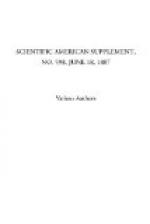The keel was laid in August, 1885, and the ship was launched July 29, 1886, on which occasion it was christened Greif. On the trial trip it was found that the slender shape of the vessel adapted it for the development of a very high rate of speed under favorable conditions, when it can make at least 22 knots an hour, so that the speed of 19 knots an hour guaranteed by the builders can certainly be reached, even when traveling at a disadvantage. In spite of its great length, the Greif can be easily maneuvered. When moving forward at full speed, it can be made to describe a circle by proper manipulation of the rudder, and by turning one screw forward and the other backward, the ship can be turned in a channel of its own length.
[Illustration: The new German war steamer Greif.]
A large and rapid cruiser, also for the German navy, is being built by the corporation “Germania”. This vessel is of about the same length as the Greif, has more than double its displacement, and will make 18 knots an hour, an unusual rate of speed for a vessel of its class. It will be launched by the last of the summer or early in the fall.
* * * * *
TWIN SCREW TORPEDO BOAT.
We give several illustrations of a sea going twin screw torpedo boat lately built for the Italian government by Messrs. Yarrow & Co., of Poplar. The vessel in question is 140 ft. long by 14 ft. wide, and her displacement approaches close on 100 tons. The engines are of the compound surface condensing type ordinarily fitted by this firm in their torpedo boats, excepting where triple compounds are fitted. The general arrangement is shown by the sectional plan. As will be noticed, there are two boilers, one before and the other aft of the engines, and either boiler is arranged to supply either or both the engines. Yarrow’s patent water tight ash pans are fitted to each boiler, to prevent the fire being extinguished by a sudden influx of water into the stokehold. There is an independent centrifugal pumping engine arranged to take its suction from any compartment of the boat. There are also steam ejectors and hand pumps to each compartment. These compartments are very numerous, as the space is much subdivided, both from considerations of strength and safety. Bow and stern rudders are fitted, each having independent steam steering gear, but both rudders can be worked in unison, or they can be immediately changed to hand gear when necessary. The accommodation is very good for a vessel of this class. Officers’ and petty officers’ cabins are aft, while the crew is berthed forward.
[Illustration: Twin screw torpedo boat for the Italian government.]




